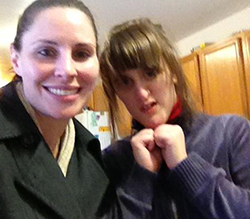
Madison and Jamie,
a caregiver for over 12 years.
This column was originally published as part of my “Tuesdays with Madison” series at AutismAfter16.com.
The search for good caregiver support can be a daunting task. Although there’s no magic to the process I’ve developed over the last 20 years, there are a few key ingredients.
Consider the Requirements
For each hire, take time to think about the current job and the skills necessary to do it well. Why do I need to hire someone? What are the most important things that I need help to do?
Advertise Clearly
Make sure to include those skills and any other unique requirements (own transportation, duration, carpool pickup, etc.) to do the job.
Screen Well
In the ad, I always ask applicants to contact me via email to start the process. This initial inquiry helps document their interest and gives me a peek into their communication style.
Due Diligence
After at least one email exchange and an initial screening phone call, each applicant then fills out a four-page “Caregiver Questionnaire.” (Click here for a copy of the questionnaire.) This questionnaire is a work-in-progress with seven key sections designed to help me assess Can Do, Will Do, and Fit, the core components to a good hiring process which I described in an earlier column. Below are the seven sections and their purpose.
- Contact: The first section gathers personal information. Note that both the home and school address is requested as well as the cell phone carrier and preferred method of communication.
- Availability: Here I request information about the applicant’s current availability as well as any planned absences. I often advertise for one timeframe, but like to know what other hours are available to be able to assess the applicant’s willingness to work beyond the required hours.
One key part of this section is the range of hours the applicant is willing to work. The minimum and maximum request gives me a quick place to look to see if our needs are a match. And it also gives me an idea of their flexibility in case I need extra hours in the future or I discover I need to cut back hours.
The question, “How long would you commit to a family,” was particularly important when I was hiring behavioral therapy assistants for my daughter with autism. I did not want to invest in a caregiver who was only able to commit to one semester. I also noted this requirement in my ad.
-
Experience/Education: In this section, I gather information about educational focus, work experience, and preferences. Again, I tailor these questions, asking for specific examples to see if their previous experiences will help them in the work I have for them.
A few years ago, I added a self-assessment checklist to help me with determining the softer attributes of the applicant that I found important but difficult to assess in a face-to-face meeting. It is surprising what applicants will reveal about themselves when asked to self-assess. This section can also be used for the, “Tell me more about” line of questioning if a particular attribute is high or low.
I also request a salary expectation.
- Duties: In this section, I list all the possible duties I may ask the applicant to perform. With each hiring bout, I update this section to make sure it matches my current requirements. I will often update this section first, before I craft the ad, just to make sure the ad reflects the most important duties. Sometimes I’ll add seasonal chores like watering the grass or wrapping presents if I think I may need help.
- Other: In this section, I’ve created one more checklist of questions that are specific to the context of the job. It is a quick way for me to double check the comfort level of the applicant with the workplace environment.
- Questions: This final section includes questions that ask the applicant what others say about their work performance—before I check their references. Then, I generally ask the references the same questions. Often the two match exactly. But if there is too great a disparity, I know there could be some issues and probe further, if I still have interest.
- References: I ask for at least two references. In addition to the questions I ask the applicant in the section above, I also ask for strengths, improvement areas, and if they would hire this person again.
Customizing the Questionnaire
When I begin to tailor the questionnaire for our particular needs at the time of hire I make sure to be specific. For example, I describe the job, the minimum duties and responsibilities. For example:
- Care from 4—6 p.m.
- Pick up from school
- Help with homework
- Prepare dinner
I list what I think are the key factors in doing this job effectively are. For example:
- Reliable transportation
- Safe driver
- Willingness to prepare dinner
- Experience with a child like mine who has autism, with behavioral challenges. If there is no directly-related experience, I look for a strong interest in autism and autism-related coursework.
In drafting the self-assessment section, I ask myself what characteristics will help this applicant be a good fit. For example:
- Patience
- Dependable
- Creative
- Anticipatory
- Quick to learn
And to assess education and experience, I ask myself what are the “nice-to-have” factors—not required, but desirable? For example:
- Long term interest in autism
- Enjoys cooking
- Organized, tidy
Although the questionnaire is a great help in gathering the “can do” and “will do” information, the “fit” factor is much more subjective. With thoughtful open-ended questions and good reference checks, however, fit is a little easier to imagine. If I’m still in doubt, however, I often ask the applicant to come into work while I am here so I can observe directly how they handle the responsibilities.
Follow Me!